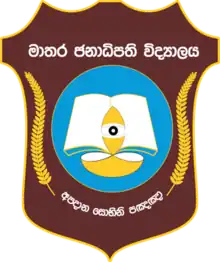Matara Janadhipathi Vidyalaya
Matara Janadhipathi Vidyalaya (මාතර ජනාධිපති විද්යාලය, President's College Matara; abbreviated JV) was established in August 1814 inside the Portuguese Fort at Matara as a missionary school, and currently falling under the purview of the Matara division educational zone.[2] The school is located on the banks of the Nilwala river, and is divided into four sections: primary (grades 1–5), middle school (grades 6–9), upper middle school (grades 10 & 11) and upper school (grades 12 & 13). The medium of instruction is Sinhala.
| Janadhipathi Vidyalaya Matara ජනාධිපති විද්යාලය මාතර | |
|---|---|
 | |
| Location | |
Wilfred Gunasekara Mawatha, Fort | |
| Coordinates | 5°56′43″N 80°32′41″E |
| Information | |
| Type | 1AB Provincial School[1] |
| Motto | Pali: අපදාන සොභිනි පඤ්ඤා apadāna sōbhini paññā (A man with knowledge stands out) |
| Established | 1914 |
| Principal | U.G.Munasinghe |
| Grades | 1–13 |
| Gender | Co-educational |
| Age range | 6 to 19 |
| Number of students | <2,500 |
| Color(s) | Maroon and gold |
| Website | http://www.janadhipathividyalaya.lk/ |
History
Janadhipathi Vidyalaya was established in 1814 August by the Rev George Erskine [3] one of the pioneer Wesleyan Methodist missionaries to arrive in then Ceylon [4]>. The Maha Mudaliyar of Matara Don David Illangakoon, J. H. Granville, Esq. the collector and Reverend J. G. Erhardt, a German Missionary, connected with the London Missionary Society assisted the Rev Erskine to form the school in the premises of the Church and it functioned as a Methodist Missionary School in the Matara Fort. It was maintained by the Ceylon Wesleyan Methodist Mission, with only Christian children being admitted. The school began with three teachers and eighty students, with its main building being the church. The school was abandoned for after nine months [5] due to the indisposition of the Rev Erskine but was revived again in 1817 with the appointment of the Rev Callaway [6]
On 17 November 1960 the school was taken under state control, and the name of the school was changed to Matara Fort Kanishta Vidyalaya. Since this nationalisation, Buddhist children have also been admitted for studies.
From 1972 to 1995, during B. Jinadasa's administration period, the number of students and teachers grew. During this period, the school area was expanded by an acquisition of 26 perches of surrounding lands.
Principals
| Place | Period | Name |
|---|---|---|
| 1st | 1960–1963 | Lionel De Silva |
| 2nd | 1963–1965 | L. Jayawardane |
| 3rd | 1965–1968 | H. A. W. Dissanayake |
| 4th | 1968–1971 | A. P. Josynona |
| 5th | 1971–1972 | P. K. Guruge |
| 6th | 1972–1995 | B. Jinadasa |
| 7th | 1995–2014 | D. Sudusinghe |
| 8th | 2014–2016 | K. W. Karunananda |
| 9th | 2016–2018 | M. B. Vineetha |
| 10th | 2018-2021 | C.Gunawardena |
References
- "ANNUALLY BULLETIN OF EDUCATION STATISTICS" (PDF). Statistics.gov.lk. 2010. Retrieved 17 May 2018.
- "4. Matara Zone". Moe.gov.lk.
- "The Island". www.island.lk. Archived from the original on 3 February 2012.
- Hardy, Spence (1864). Jubilee Memorials of the Wesleyan Mission 1814-1864. Wesleyan Press, Colombo, Ceylon. pp. 227~229.
- A Narrative of the Establishment and Progress of the Mission to Ceylon - William M. Harvard page 286
- The First Report of the General Wesleyan Methodist Missionary Society 1818; p. 9
- "Matara Janadipathi Vidyalaya". PCM magazine. February 2007.